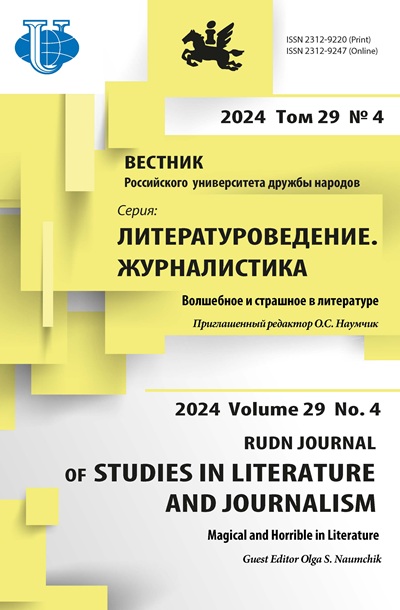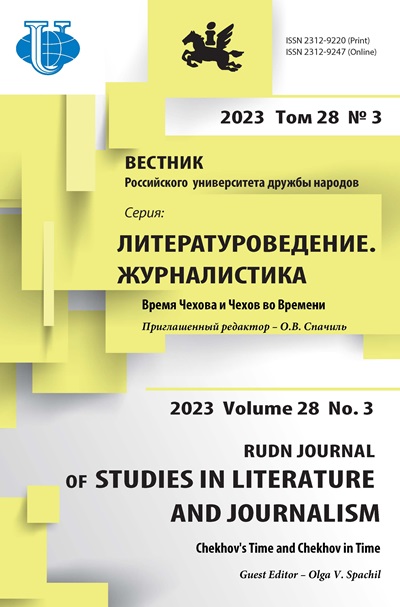Micro movie from cinemas to online video platforms: terminology issues
- Authors: Litvintsev A.E.1, Proskurnova E.L.2
-
Affiliations:
- Lomonosov Moscow State University
- RUDN University
- Issue: Vol 28, No 3 (2023): Chekhov’s Time and Chekhov in Time
- Pages: 574-584
- Section: JOURNALISM
- URL: https://journals.rudn.ru/literary-criticism/article/view/36798
- DOI: https://doi.org/10.22363/2312-9220-2023-28-3-574-584
- EDN: https://elibrary.ru/LRQWAG
Cite item
Full Text
Abstract
A comprehensive study of the phenomenon of microcinema is presented. The tasks of semantic analysis of the concept of “microcinema” are set and solved, its characteristic features are discovered and, on the basis of the results obtained, an actual definition of the term is proposed for the first time; it is revealed on which screens the ultra-short meter exists today. The hypothesis that ultrashort films as a phenomenon cannot be fully considered as a product of the digital era is substantiated, this form inherits classical cinema, although it’s presented to the audience at other, modern venues. This problem is considered in view of the widespread interpretation of the term “microcinema” as a format that arose in the 21st century in the network space. As the main difference from various kinds of ultra-short audio-visual content posted online, the focus of micro movie on the coverage of philosophical, life problems, the search for new meanings, the demonstration of the author's views on existential issues is indicated. As a result of studying the filmography of reputable international film festivals, this assumption is confirmed. The boundaries of the timing of ultrashort films are revealed, for which the requirements put forward by specialized microcinema festivals to authors are investigated.
Keywords
About the authors
Alexey E. Litvintsev
Lomonosov Moscow State University
Email: avtorsky@list.ru
ORCID iD: 0009-0003-6484-232X
Candidate of Philology, Associate Professor of the Television and Radio Broadcasting Department, Journalism Faculty
1 Leninskie Gory, Moscow, 119991, Russian FederationEvgeniya L. Proskurnova
RUDN University
Author for correspondence.
Email: karikh.el@gmail.com
ORCID iD: 0000-0002-2985-7898
Candidate of Philology, lecturer, Department of Mass Communications, Faculty of Philology
6 Miklukho-Maklaya St, Moscow, 117198, Russian FederationReferences
- Ageeva, G.M., Antipkina, E.N., & Sidorkina, T.N. (2016). The role of visual arts in popularizing the culture of Finno-Ugric peoples. Finno-Ugric world, 26(1), 84–88. (In Russ.)
- Alekhina, O.A., & Ukolova, L.E. (2020). Cinematography as one of the methods of forming the information space of aerospace industry organizations in Russia. Communicology, 8(1), 155–166. (In Russ.) https://doi.org/10.21453/2311-3065-2020-8-1-155-166
- Arapova, O.G. (2020). Short movies as a means of increasing motivation when teaching Russian as a Foreign Language. Herald of Vyatka State University, 138(4), 108–117. (In Russ.) https://doi.org/10.25730/VSU.7606.20.061
- Bajrakimov, A.B. (2016). A short film as a method of educating a film director. APRIORI. Series: Humanities, (2), 5–6. (In Russ.)
- Bogdanovskaya, I.M., Uglova, A.B., Nizomutdinov, B.A., & Nikolskaya A.S. (2023). Modern practices of media consumption among students. World of Science. Pedagogy and Psychology, 11(2), 10PSMN223. (In Russ.) Available from: https://mir-nauki.com/10PSMN223.html (accessed: 10.02.2023).
- Chen, Y., Li, M., Guo, F., & Wang, X. (2022). The effect of short-form video addiction on users’ attention. Behaviour & Information Technology. https://doi.org/10.1080/0144929X.2022.2151512
- Dunkevich, S.G., & Somov, M.V. (2020). The role of cinema in the aesthetic education of young people. Society: Sociology, Psychology, Pedagogy, 78(10), 90–94. (In Russ.)
- Gabrielyan, A.A. (2017). Reflection of the key value dominants in American cinema of the second half of the XX ‒ beginning of the XXI century. Moscow University Bulletin. Series 19. Linguistics and Intercultural Communication, (4), 161–169. (In Russ.)
- Gilardi, F., White, A., Cheng, S., Sheng, J., Song, W., & Zhao, Y. (2020). How online video platforms could support China’s independent microfilm (short film) makers and enhance the Chinese film industry. Cultural Trends, 29(1), 35–49. https://doi.org/10.1080/09548963.2019.1697852
- Jwo, J.S. (2015). Teaching software engineering through comics and micro-movie design projects. 10th International Conference on Computer Science & Education (ICCSE). (In Chin.) https://doi.org/10.1109/ICCSE.2015.7250265
- Kajzer, O.M., & Shishkova, L.Y. (2020). Social adaptation of children and adolescents through cinematography. Science and Education Today, 56(9), 51–53. (In Russ.)
- Kaneeva, A.V., & Kozhanova, K.A. (2022). Features of the use of films as a linguodidactic material in teaching a foreign language (on the example of the film “Chateau Mouton Rothschild”). The Humanities and Social Sciences, 91(4). 143–147. (In Russ.) https://doi.org/10.18522/2070-1403-2022-93-4-143-147
- Kruglova, L.A., Chobanyan, K.V., & Shchepilova, G.G. (2020). Online video: Structure, content, monetization. Moscow: Aspect Press. (In Russ)
- Li, C.H., & Liu, C.C. (2020). The effects of empathy and persuasion of storytelling via tourism micro-movies on travel willingness. Asia Pacific Journal of Tourism Research, 25(4), 382–392. https://doi.org/10.1080/10941665.2020.1712443
- Polunina, T.S. (2021). Methods of working with short videos in remote English classes with Chinese students. Yaroslavskij Pedagogicheskij Vestnik, 120(3), 55–61. (In Russ.) https://doi.org/10.20323/1813-145X-2021-3-120-55-61
- Proskurnova, E.L., Volkova, I.I., & Tran Thi Thuy Dung. (2021). Prospects of news television: Materials of in-depth interviews. Nauchnyi Dialog, (3), 157–170. (In Russ.) https://doi.org/10.24224/2227-1295-2021-3-157-170
- Rodionova, Y.V. (2021). Digital short film production tools. Creativity and Modernity, 14(1), 95–98. (In Russ.) https://doi.org/10.37909/978-5-89170-278-3-2021-1016
- Sergan, D.O. (2020). Perlocutionary effect and ways to achieve it (using the example of the analysis of the short drama “The Old Man and the Sea” directed by Alexander Petrov). Bulletin of Science and Creativity, 73(1), 91–93. (In Russ.)
- Shekova, E.L. (2018). Crowdfunding as an actual source of funding for the youth projects in the national film industry. St. Petersburg Economic Journal, (1), 77–84. (In Russ.)
- Volkova, I.I. (2019). TV channels on YouTube: Reasons for ineffectiveness. Journalism in 2018: Creativity, Profession, Industry: Materials of the International Scientific and Practical Conference (pp. 468‒469). Moscow: MSU Publ. (In Russ.)
- Wang, W., Pan, Y., Wu, S., & Dai, Z. (2022). Research on short format video application design strategy based on user experience and emotion regulation. International Journal of Neuropsychopharmacology, 25(1), A69–A70. https://doi.org/10.1093/ijnp/pyac032.096
- Zhang, J., & Yuan, S. (2018). The exploration of low cost micro film creation in the hot background of micro film in colleges and universities. Advances in Computer Science Research: 8th International Conference on Social Network, Communication and Education (SNCE 2018). https://doi.org/10.2991/snce-18.2018.204
- Zhang, L. (2022). Research on new media film and television works. Art and Design Review, 10, 337–347. https://doi.org/10.4236/adr.2022.103025
- Zhao, J.E. (2014). The micro-movie wave in a globalising China: Adaptation, formalisation and commercialization. International Journal of Cultural Studies, 17(5). https://doi.org/10.1177/1367877913505171
- Zhdankina, G.I., & Shipulina, N.B. (2020). Short films: Genre originality of debuts. Vestnik VGIK, 12(3), 68–78. (In Russ.) https://doi.org/10.17816/VGIK25732
















